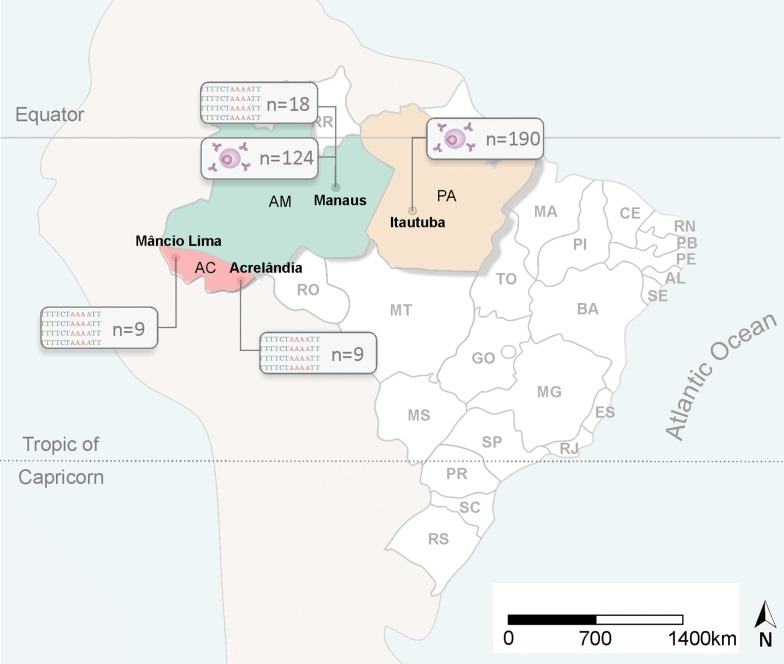Genetic sequence characterization and naturally acquired immune response to Plasmodium vivax Rhoptry Neck Protein 2 (PvRON2).
The genetic diversity of malaria antigens often results in allele variant-specific immunity, imposing a great challenge to vaccine development. Rhoptry Neck Protein 2 (PvRON2) is a blood-stage antigen that plays a key role during the erythrocyte invasion of Plasmodium vivax. This study investigates the genetic diversity of PvRON2 and the naturally acquired immune response to P. vivax isolates. Here, the genetic diversity of PvRON2 1828-2080 and the naturally acquired humoral immune response against PvRON2 1828-2080 in infected and non-infected individuals from a vivax malaria endemic area in Brazil was reported. The diversity analysis of PvRON2 1828-2080 revealed that the protein is conserved in isolates in Brazil and worldwide. A total of 18 (19%) patients had IgG antibodies to PvRON2 1828-2080 . Additionally, the analysis of the antibody response in individuals who were not acutely infected with malaria, but had been infected with malaria in the past indicated that 32 patients (33%) exhibited an IgG immune response against PvRON2. PvRON2 was conserved among the studied isolates. The presence of naturally acquired antibodies to this protein in the absence of the disease suggests that PvRON2 induces a long-term antibody response. These results indicate that PvRON2 is a potential malaria vaccine candidate.
Authors
Najara C Bittencourt; Juliana A Leite; Ana Beatriz I E Silva; Tamirys S Pimenta; João Luiz Silva-Filho; Gustavo C Cassiano; Stefanie C P Lopes; Joao C K Dos-Santos; Catarina Bourgard; Helder I Nakaya; Ana Maria Revorêdo da Silva Ventura; Marcus V G Lacerda; Marcelo U Ferreira; Ricardo L D Machado; Letusa Albrecht; Fabio T M Costa
External link
Publication Year
Publication Journal
Associeted Project
Microbiology or Immunology
Lista de serviços
-
Gene regulatory and signaling networks exhibit distinct topological distributions of motifs.Gene regulatory and signaling networks exhibit distinct topological distributions of motifs.
-
Gene signatures of autopsy lungs from obese patients with COVID-19.Gene signatures of autopsy lungs from obese patients with COVID-19.
-
Network Medicine: Methods and ApplicationsNetwork Medicine: Methods and Applications
-
ACE2 Expression Is Increased in the Lungs of Patients With Comorbidities Associated With Severe COVID-19.ACE2 Expression Is Increased in the Lungs of Patients With Comorbidities Associated With Severe COVID-19.
-
Drug repositioning for psychiatric and neurological disorders through a network medicine approach.Drug repositioning for psychiatric and neurological disorders through a network medicine approach.
-
Linking proteomic alterations in schizophrenia hippocampus to NMDAr hypofunction in human neurons and oligodendrocytes.Linking proteomic alterations in schizophrenia hippocampus to NMDAr hypofunction in human neurons and oligodendrocytes.
-
In-depth analysis of laboratory parameters reveals the interplay between sex, age, and systemic inflammation in individuals with COVID-19.In-depth analysis of laboratory parameters reveals the interplay between sex, age, and systemic inflammation in individuals with COVID-19.
-
The evolution of knowledge on genes associated with human diseasesThe evolution of knowledge on genes associated with human diseases
-
Network vaccinology.Network vaccinology.
-
Pyruvate kinase M2 mediates IL-17 signaling in keratinocytes driving psoriatic skin inflammationPyruvate kinase M2 mediates IL-17 signaling in keratinocytes driving psoriatic skin inflammation
-
Transcriptome analysis of six tissues obtained post-mortem from sepsis patientsTranscriptome analysis of six tissues obtained post-mortem from sepsis patients
-
Gene Signatures of Symptomatic and Asymptomatic Clinical-Immunological Profiles of Human Infection by Leishmania (L.) chagasi in Amazonian BrazilGene Signatures of Symptomatic and Asymptomatic Clinical-Immunological Profiles of Human Infection by Leishmania (L.) chagasi in Amazonian Brazil
-
In vitro morphological profiling of T cells predicts clinical response to natalizumab therapy in patients with multiple sclerosis.In vitro morphological profiling of T cells predicts clinical response to natalizumab therapy in patients with multiple sclerosis.
-
Integrative immunology identified interferome signatures in uveitis and systemic disease-associated uveitis.Integrative immunology identified interferome signatures in uveitis and systemic disease-associated uveitis.
-
Gene regulatory networks analysis for the discovery of prognostic genes in gliomas.Gene regulatory networks analysis for the discovery of prognostic genes in gliomas.
-
Revealing shared molecular drivers of brain metastases from distinct primary tumors.Revealing shared molecular drivers of brain metastases from distinct primary tumors.

